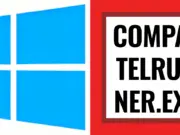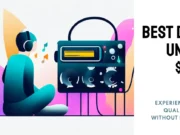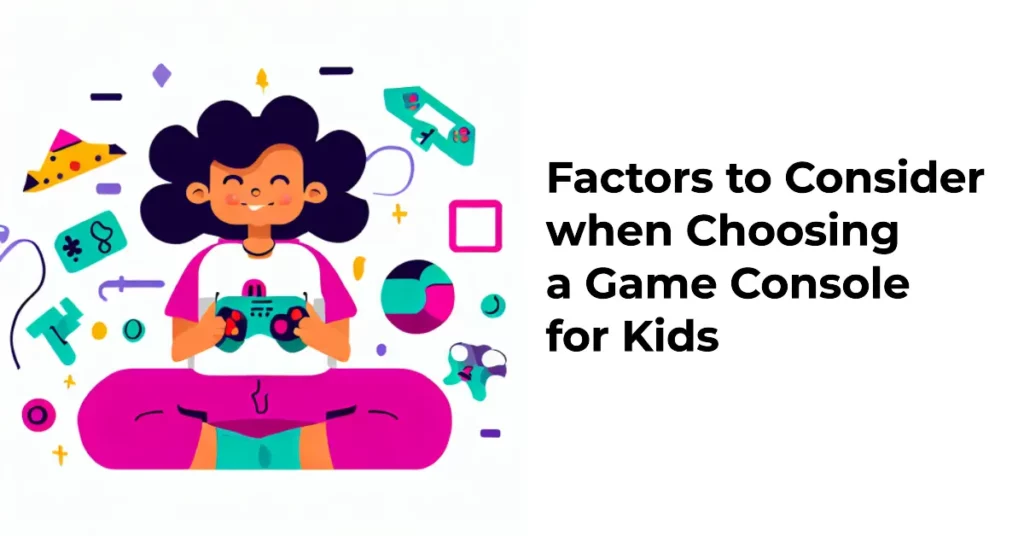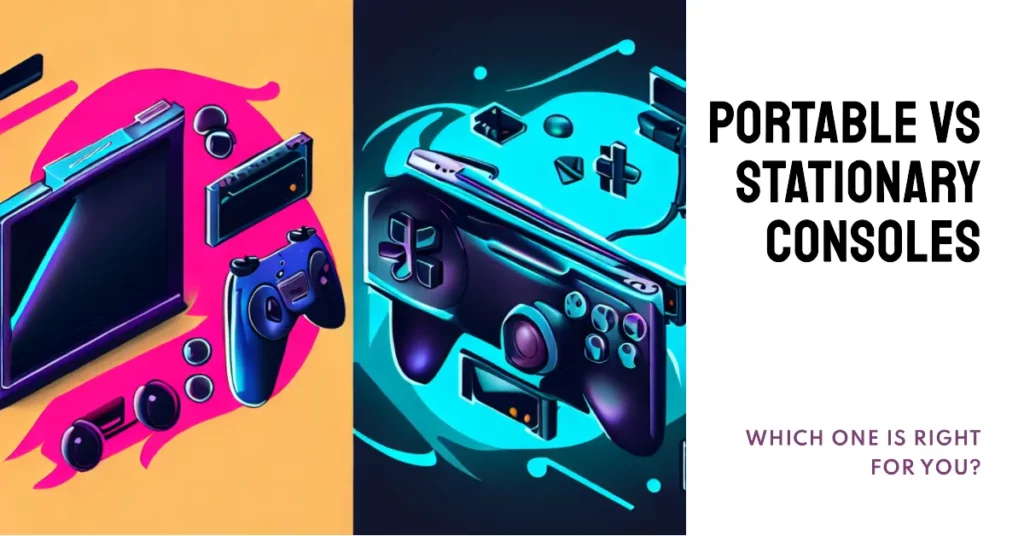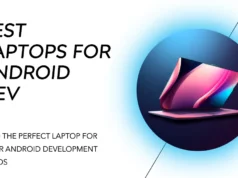Choosing the right game console for kids can be a daunting task. With a wide variety of options available in the market, it’s difficult to decide which offers the right balance between entertainment, education, safety, and affordability.
You want your kids to have fun and possibly learn something from the experience, but at the same time, you need to ensure that the content is age-appropriate and the gaming experience is safe.
Think about the frustration of purchasing a game console only to realize later that it’s not age-appropriate, too complicated, or lacks parental controls to ensure your child’s safety online.
Or perhaps you find out that the games your kids want to play aren’t available on your chosen platform. The feeling of regret can be overwhelming – it’s like you’ve wasted your money, and worse, you might have exposed your children to unsuitable content.
But what if I told you that you can make an informed decision and pick the best game console for your kids with confidence? In this article, we’re going to demystify the process. We will examine various game consoles, explore their pros and cons, and understand what makes each suitable (or not) for kids.
We’ll look at important aspects such as available games, age appropriateness, ease of use, parental controls, and cost, so you can decide which is the ‘Best Game Console for Kids.’
Let’s embark on this journey to find the perfect gaming companion for your little ones.
Factors to Consider when Choosing a Game Console for Kids
In the fast-paced world of gaming technology, selecting the ideal game console for your child can be daunting. Parents must embark on a discerning journey to make an informed decision, with many options flooding the market.
Several crucial factors warrant careful examination to ensure a harmonious blend of entertainment, education, and safety.
Age-appropriate Content:- Foremost, it is imperative to consider the age-appropriateness of the games available on the console. Age classifications, determined by reputable gaming bodies, facilitate the selection of games that align with your child’s developmental stage and sensibilities.
Younger children may benefit from consoles offering a rich collection of educational and non-violent games, whereas teenagers may enjoy more complex and challenging gaming experiences.
Parental Controls:- In an ever-connected world, parental controls emerge as an indispensable aspect of a game console. Ensuring the chosen console offers robust parental control features empowers parents to manage and monitor their child’s gaming activities.
Such controls provide the ability to set time limits, restrict access to certain content, and monitor online interactions, thus fostering a safe and secure gaming environment.
Physical and Mental Development:- Another aspect to deliberate is how the chosen game console aligns with your child’s physical and mental development. Consoles that incorporate motion-sensing technology promote physical activity, while those with puzzles and strategy games stimulate cognitive abilities. Striking the right balance between entertainment and edification is key.
Multiplayer and Social Interaction:- For kids who enjoy social gaming experiences, opting for a console with multiplayer capabilities might be a wise choice. Multiplayer functionality enables children to engage in virtual collaborations and competitions, fostering teamwork, communication skills, and sportsmanship.
System Exclusives and Game Library:- Evaluating the console’s exclusive titles and overall game library can significantly influence your decision. Each console boasts unique games that may cater to specific interests. Scrutinizing the titles available on different platforms can unveil opportunities for your child to explore various genres and experiences.
In conclusion, choosing an appropriate game console for kids demands thoughtful consideration of age-appropriate content, the presence of parental controls, alignment with physical and mental development, multiplayer and social interaction possibilities, and the available game library.
Parents can present their children with an enjoyable, safe, and enriching gaming experience by engaging in this discerning process.
Review of Popular Game Console For Kids
1. Nintendo Switch – Best Overall
In gaming, the Nintendo Switch, with its captivating Neon Blue and Neon Red Joy-Con, has emerged as the quintessential game console for kids, amalgamating innovation, versatility, and a wholesome gaming experience.
Its remarkable adaptability between handheld and home console modes makes it a compelling choice for youngsters seeking seamless gaming escapades.
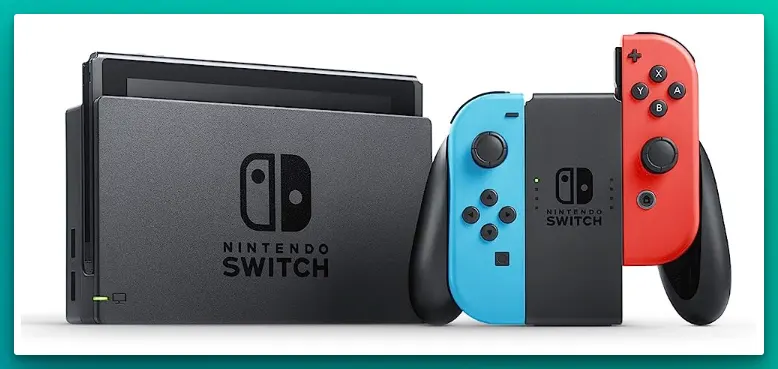
The Nintendo Switch boasts an extensive and diverse game library catering to the varied interests of young players. From the enthralling world of Super Mario Odyssey to the creativity of Minecraft, the console offers an array of captivating titles that foster cognitive development, problem-solving skills, and imaginative thinking.
Including detachable Joy-Con controllers introduces an element of interactivity that enhances gameplay. Its intuitive motion controls, responsive buttons, and haptic feedback immerse children in a world where their actions directly impact the game. This fosters a sense of agency and engagement, making the gaming experience more enriching.
Nintendo’s commitment to family-friendly content ensures that parents can confidently endorse the console for their kids. The platform’s content moderation and parental control features reassure guardians of a safe gaming environment.
Beyond pure entertainment, the Nintendo Switch serves as an educational tool, with several games designed to impart knowledge and encourage learning in a fun manner. From geography quizzes in GeoGuessr to physics challenges in Snipperclips, the console fosters cognitive growth while delivering enjoyment.
In conclusion, the Nintendo Switch stands unparalleled as the best game console for kids. Its adaptability, expansive game library, interactive Joy-Con controllers, and focus on family-friendly and educational gaming experiences render it a remarkable and commendable choice for young players embarking on exciting gaming journeys.
Pros:-
Versatility: The Nintendo Switch’s ability to switch seamlessly between handheld and home console modes allows kids to enjoy gaming or immerse themselves in a larger screen experience at home.
Family-Friendly Content: With a focus on age-appropriate and family-friendly games, parents can feel confident allowing their kids to explore the console’s library without worrying about inappropriate content.
Interactive Gameplay: The detachable Joy-Con controllers offer motion controls and haptic feedback, providing children with a more engaging and interactive gaming experience.
Educational Potential: Several games on the platform are entertaining and have educational value, helping kids learn and develop various skills while having fun.
Portability: The compact design of the Nintendo Switch makes it easy for kids to take their gaming adventures wherever they go, whether on a road trip or during family vacations.
Social Gaming: The console supports local multiplayer gaming, allowing kids to enjoy games with friends and family, promoting social interaction and teamwork.
Cons:-
Price: The initial cost of the Nintendo Switch and additional accessories like games and controllers can be relatively high, making it a considerable investment for some families.
Battery Life: While the Switch offers portability, its battery life may not be sufficient for long gaming sessions, especially during extended travel.
Limited Processing Power: Compared to other gaming consoles, the Nintendo Switch’s processing power is relatively lower, which might affect the graphical fidelity of some games.
Online Subscription Fee: To access online multiplayer features and other online services, a subscription to Nintendo Switch Online is required, adding an extra ongoing cost.
Fragile Joy-Con: Some users have reported issues with the durability of the Joy-Con controllers, especially when used by younger children who may not handle them with as much care.
Storage Capacity: The base model of the Nintendo Switch comes with limited internal storage, which may require additional microSD cards to store more games and data.
Despite these cons, the Nintendo Switch’s overall appeal and focus on providing a fun, interactive, and family-friendly gaming experience make it a top choice for kids and their parents.
Age Group Recommendations:-
Young Children (Ages 6-9): The Nintendo Switch offers a selection of games suitable for young children, featuring colorful visuals, simple gameplay mechanics, and educational content. Parental supervision and age-appropriate game choices are crucial for this age group.
Preteens (Ages 10-12): As kids age, they can explore a broader range of games on the Nintendo Switch. At this stage, they may enjoy more challenging games that involve problem-solving, creativity, and social interaction.
Teenagers (Ages 13+): Teenagers can fully embrace the Nintendo Switch, delving into more complex and strategic games. The console’s multiplayer capabilities provide opportunities for online gaming and bonding with friends.
Parents must set appropriate screen time limits, encourage breaks, and ensure that the content their children access aligns with their maturity level. Additionally, utilizing the parental control features of the Nintendo Switch can further enhance a safe and enjoyable gaming experience for kids of all ages.
Popular kid’s games available on the platform:-
The Nintendo Switch boasts an impressive library of popular kids’ games, offering various genres and experiences suitable for young players. Here are some of the most beloved and widely acclaimed kids’ games available on the platform:
Super Mario Odyssey: Join Mario on an epic 3D platforming adventure across various imaginative worlds to rescue Princess Peach from Bowser’s clutches.
Animal Crossing: New Horizons: Create and customize your island paradise in this relaxing life simulation game, where you can fish, catch bugs, and interact with cute animal villagers.
Mario Kart 8 Deluxe: Race with iconic Nintendo characters in exhilarating kart races, using power-ups and shortcuts to secure victory on colorful and exciting tracks.
Minecraft: Unleash your creativity in this sandbox game, building and exploring limitless blocky worlds while facing challenges and crafting your adventures.
Luigi’s Mansion 3: Embark on a spooky and comical journey as Luigi, equipped with the Poltergust G-00, to rescue his friends from the haunted Last Resort hotel.
Pokémon: Let’s Go, Pikachu! / Let’s Go, Eevee!: Experience a nostalgic and accessible Pokémon adventure, capturing and battling Pokémon with the help of your trusted partner, Pikachu or Eevee.
Yoshi’s Crafted World: Help Yoshi navigate charming and crafty side-scrolling levels, uncovering secrets and collecting items in this delightful platformer.
Splatoon 2: Engage in colorful and chaotic team-based battles as squid-like Inklings in this unique, family-friendly multiplayer shooter.
Kirby Star Allies: Accompany Kirby on a heartwarming journey, befriending enemies and combining their powers to save Dream Land in this charming platformer.
Super Mario Party: Enjoy a collection of mini-games with friends and family as you compete and cooperate in various entertaining challenges.
These games exemplify the Nintendo Switch’s appeal as a fantastic game console for kids, providing enjoyable and age-appropriate experiences that cater to various interests and skill levels.
2. PlayStation 5
In the ever-evolving gaming landscape, the PlayStation 5 emerges as a frontrunner, captivating both seasoned gamers and novices alike.
However, beyond its cutting-edge technology and dazzling graphics, the PlayStation 5 as the best game console for kids stands undeniable, offering a trove of immersive experiences that foster entertainment, education, and development.
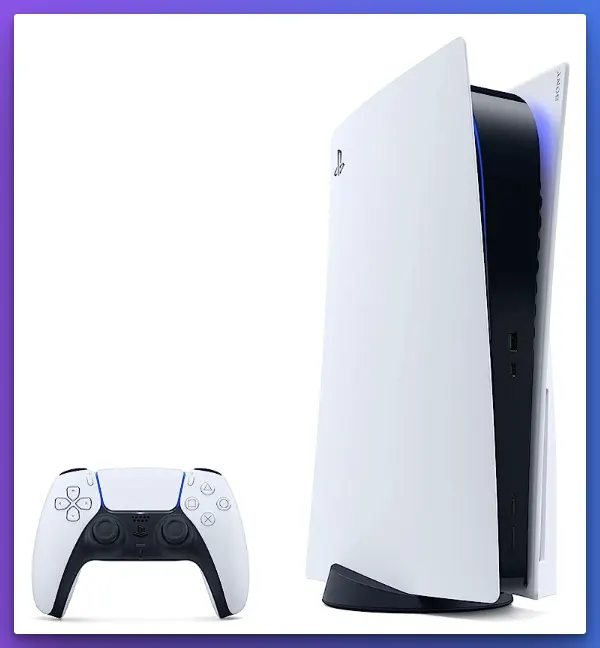
At the heart of the PlayStation 5 lies a formidable powerhouse featuring a custom-designed AMD processor, bringing unprecedented graphics and smooth gameplay. The console’s SSD technology eliminates loading times, ensuring that young players remain engrossed in their adventures without interruptions.
The PlayStation 5 boasts an extensive and diverse game library, including exclusive titles such as Ratchet & Clank: Rift Apart, Astro’s Playroom, and Sackboy: A Big Adventure. These games cater to various age groups and interests, introducing kids to imaginative worlds, thrilling challenges, and heartwarming storytelling.
With the innovative DualSense controller, the PlayStation 5 delivers interaction beyond imagination. The controller’s adaptive triggers and haptic feedback create immersive sensations that synchronize with on-screen events, heightening excitement and engagement for young players.
Beyond pure entertainment, the PlayStation 5 offers educational value through games that stimulate critical thinking, problem-solving, and creativity. Titles like LittleBigPlanet 3 and Concrete Genie empower kids to express themselves, fostering artistic talents and unleashing boundless potential.
The PlayStation 5’s robust parental control features ensure parental peace of mind. These tools allow caregivers to manage screen time, restrict access to age-inappropriate content, and ensure a secure gaming environment for children.
In conclusion, the PlayStation 5, the best game console for kids, amalgamates cutting-edge technology, diverse gaming experiences, interactive gameplay, and educational potential.
As young players embark on unforgettable journeys, the console becomes more than just a gaming device, evolving into a gateway that nurtures creativity, imagination, and personal growth. With the PlayStation 5, the infinite possibilities are promising a future where kids thrive as gamers and well-rounded individuals.
Pros:-
Outstanding Gaming Performance: The PlayStation 5’s powerful hardware ensures stunning graphics, smooth gameplay, and virtually no loading times, offering an immersive gaming experience for kids.
Vast and Diverse Game Library: With a rich selection of games catering to different genres and age groups, kids can explore various adventures and stories on the platform.
Innovative DualSense Controller: The DualSense controller’s advanced features, such as adaptive triggers and haptic feedback, add a new dimension of interactivity, making gaming more engaging and enjoyable.
Exclusive Titles: The console’s exclusive titles, specifically designed for the PlayStation platform, offer unique and unforgettable experiences that can only be enjoyed on the PS5.
Educational and Creative Games: Several games on the PlayStation 5 promote learning, critical thinking, and creativity, providing kids with entertainment and educational value.
Parental Control Features: The PlayStation 5’s robust parental control options allow parents to manage screen time, restrict access to certain content, and create a safe gaming environment for their children.
Cons:-
High Price Point: The PlayStation 5’s initial cost and additional expenses for games and accessories can be a significant investment for families.
Limited Availability: Due to high demand and supply constraints, the PlayStation 5 may be challenging to find in some regions, making it less accessible to potential buyers.
Online Subscription Fee: A PlayStation Plus subscription is required to access online multiplayer and certain features, adding an ongoing cost to the gaming experience.
Mature Content: While the PlayStation 5 offers family-friendly games, it also has a selection of titles geared toward older players, requiring careful supervision by parents.
Storage Space: The standard storage capacity of the PlayStation 5 may fill up quickly, necessitating the purchase of additional storage solutions to accommodate more games.
Potential for Excessive Screen Time: As with any gaming console, excessive screen time is risky if not managed properly, leading to potential health and developmental concerns.
Despite these drawbacks, the PlayStation 5’s exceptional gaming performance, diverse game library, innovative controller, and educational potential make it a top contender as the best game console for kids, providing a platform for exciting adventures and learning experiences.
Age Group Recommendations:-
Preteens (Ages 10-12): The PlayStation 5 offers a variety of family-friendly and age-appropriate games suitable for preteens. Children can handle more complex gameplay mechanics at this age and enjoy the diverse titles available on the platform.
Teenagers (Ages 13+): Teenagers can fully explore the capabilities of the PlayStation 5, immersing themselves in a broader range of games, including those with deeper narratives, challenging gameplay, and multiplayer experiences.
Parental Guidance: While the PlayStation 5 has a wide selection of family-friendly games, some titles may have content more suitable for older audiences. Parents should actively monitor their children’s games and use the console’s parental control features to ensure a safe and appropriate gaming experience.
Parents need to consider the content ratings of games and assess their child’s maturity and ability to handle the content presented in various titles. Parents can create a positive gaming experience that aligns with their child’s age and individual development by providing proper guidance and supervision.
Popular kid’s games available on the platform:-
The PlayStation 5 offers a diverse selection of popular kids’ games that cater to various interests and age groups.
Here are some of the most beloved and widely acclaimed kids’ games available on the platform:
Ratchet & Clank: Rift Apart: Join the intergalactic duo, Ratchet, and Clank, on a thrilling adventure across different dimensions filled with action, humor, and fantastic gadgets.
Astro’s Playroom: Explore a delightful platformer that showcases the capabilities of the PlayStation 5’s DualSense controller, providing a charming and interactive gaming experience.
Sackboy: A Big Adventure: Embark on a whimsical journey as Sackboy, the lovable hero from the LittleBigPlanet series, to save Craftworld from the villainous Vex.
Minecraft: Enter the blocky world of Minecraft, where kids can unleash their creativity, build structures, and explore limitless adventures.
LEGO Marvel Super Heroes: Team up with iconic Marvel superheroes in a family-friendly LEGO adventure, saving the world from supervillains and enjoying humorous storytelling.
Spyro Reignited Trilogy: Join Spyro the Dragon in this remastered collection as he embarks on nostalgic platforming adventures filled with dragons, gems, and exciting challenges.
Crash Bandicoot 4: It’s About Time: Play as Crash or Coco in this action-packed platformer, traveling through time and space to thwart the evil Dr. Neo Cortex.
Sonic Colors: Ultimate: Speed through colorful levels as Sonic the Hedgehog, stopping Dr. Eggman’s plans and rescuing the alien Wisps.
LittleBigPlanet 3: Unleash creativity in this imaginative platformer, customizing your Sackboy or Sackgirl, and exploring user-generated levels.
Disney Classic Games Collection: Rediscover beloved Disney classics with timeless games featuring characters like Aladdin, The Lion King, and more.
These popular kids’ games on the PlayStation 5 offer captivating adventures, engaging gameplay, and family-friendly content, making the console an excellent choice for young players and their families.
3. Xbox Series X
With its cutting-edge technology and prowess, Xbox Series X has positioned itself as a frontrunner in the gaming realm. Beyond its reputation as a powerhouse for hardcore gamers, the console’s suitability for young players is undeniable, making it an exceptional choice as a game console for kids.
From immersive gaming experiences to educational content, the Xbox Series X caters to diverse interests and age groups, promising endless entertainment and growth.
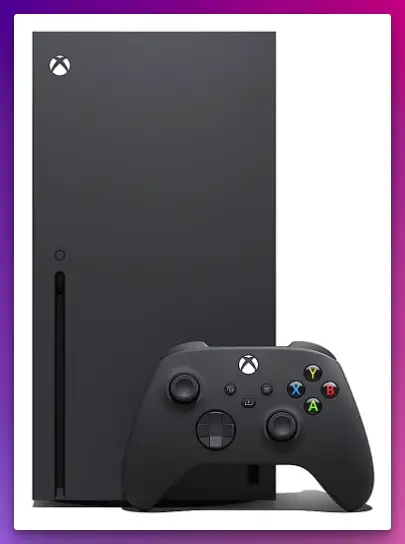
At the core of the Xbox Series X lies a custom AMD Zen 2 processor and RDNA 2 graphics, delivering jaw-dropping visuals and seamless gameplay. The console’s Quick Resume feature allows kids to switch between games swiftly, keeping them engaged and immersed in their adventures.
With an expansive and diverse game library, the Xbox Series X offers many options for young players. From the imaginative world of Minecraft to the family-friendly excitement of Rare Replay, there’s a game to pique every child’s interest.
Microsoft’s dedication to a family-friendly gaming environment is evident in the Xbox Series X. Robust parental controls enable caregivers to manage screen time, regulate content access, and ensure a safe digital space for kids to explore.
Beyond entertainment, the Xbox Series X provides educational value through games that promote critical thinking, problem-solving, and creativity. Titles like Sesame Street: Once Upon a Monster and Ori and the Blind Forest foster learning while kindling a love for exploration.
In conclusion, the Xbox Series X proves its mettle through its outstanding performance, extensive game library, family-friendly features, and educational potential.
Whether embarking on epic quests or exploring educational realms, young players can immerse themselves in a world of possibilities, making the Xbox Series X a commendable and well-rounded choice for kids of all ages.
Pros:-
Powerful Performance: The Xbox Series X’s cutting-edge hardware delivers exceptional graphics and smooth gameplay, providing a high-quality gaming experience for kids.
Extensive Game Library: With a vast selection of games suitable for various age groups, kids can access various titles catering to their interests and preferences.
Quick Resume Feature: The Quick Resume feature allows kids to switch between games seamlessly, enhancing convenience and minimizing downtime.
Family-Friendly Environment: The Xbox Series X offers robust parental control options, allowing parents to manage screen time, regulate content access, and ensure a safe gaming environment for their children.
Xbox Game Pass: With Xbox Game Pass, kids can access various games, including family-friendly and educational titles, expanding their gaming horizons.
Educational and Creative Games: Several games on the platform promote learning, problem-solving, and creativity, providing kids with entertainment and educational benefits.
Cons:-
High Price Point: The initial cost of the Xbox Series X and additional expenses for games and accessories can be a significant investment for families.
Online Subscription Fee: To access online multiplayer and certain features, an Xbox Live Gold subscription is required, adding an ongoing cost to the gaming experience.
Mature Content: While the Xbox Series X offers family-friendly games, it also has a selection of titles geared toward older players, necessitating parental supervision and careful game selection.
Large Size: The console’s bulky design might not be as portable or easily accessible for younger kids to set up and use independently.
Storage Space: The standard storage capacity of the Xbox Series X may fill up quickly, requiring the purchase of additional storage solutions to accommodate more games.
Controller Size: The size and weight of the Xbox Series X controller might be less comfortable for smaller hands, especially for very young children.
Despite these drawbacks, the Xbox Series X’s outstanding performance, extensive game library, family-friendly features, and educational potential make it a top choice as a game console for kids, offering a platform for immersive gaming experiences and enriching content.
Age Group Recommendations:-
Preteens (Ages 10-12): The Xbox Series X offers a diverse selection of family-friendly games suitable for preteens. Children can handle more complex gameplay mechanics at this age and enjoy the wide variety of titles on the platform.
Teenagers (Ages 13+): Teenagers can fully explore the capabilities of the Xbox Series X, immersing themselves in a broader range of games, including those with deeper narratives, challenging gameplay, and multiplayer experiences.
Parental Guidance: While the Xbox Series X offers family-friendly games, some titles may have content more suitable for older audiences. Parents should actively monitor their children’s games and use the console’s parental control features to ensure a safe and appropriate gaming experience.
Parents need to consider the content ratings of games and assess their child’s maturity and ability to handle the content presented in various titles. Parents can create a positive gaming experience that aligns with their child’s age and individual development by providing proper guidance and supervision.
Popular kid’s games available on the platform:–
The Xbox Series X offers a wide selection of popular kids’ games that cater to various interests and age groups. Here are some of the most beloved and widely acclaimed kids’ games available on the platform:
Minecraft: Dive into the blocky world of Minecraft, where kids can unleash their creativity, build structures, and explore limitless adventures.
Roblox: Join a vast online community where kids can create games, play games created by others, and engage in social interactions.
LEGO Video Games Series: Enjoy various LEGO-themed video games based on popular franchises like LEGO Star Wars, LEGO Marvel Super Heroes, and LEGO Harry Potter.
Super Lucky’s Tale: Embark on a charming platforming adventure with Lucky, the curious and endearing fox, as he seeks to save the Book of Ages.
Crash Bandicoot 4: It’s About Time: Play as Crash or Coco in this action-packed platformer, traveling through time and space to thwart the evil Dr. Neo Cortex.
New Super Lucky’s Tale: Join Lucky on a delightful 3D adventure, exploring colorful worlds and facing quirky challenges.
Sonic Mania: Speed through classic and revamped Sonic levels as the iconic blue hedgehog, Sonic, and his friends.
Ori and the Will of the Wisps: Experience an emotional and visually stunning platformer as Ori, a guardian spirit, on a quest to save the forest and its inhabitants.
Yooka-Laylee and the Impossible Lair: Help Yooka and Laylee rescue the Royal Beettalion and take on the dastardly Capital B in this engaging 2.5D platformer.
Disney Classic Games Collection: Rediscover beloved Disney classics with timeless games featuring characters like Aladdin, The Lion King, and more.
These popular kids’ games on the Xbox Series X provide engaging and family-friendly experiences, making the console an excellent choice for young players and their families.
4. Nintendo Switch Lite
The Nintendo Switch Lite, adorned in the captivating Turquoise hue, has emerged as an exemplary game console for young players, redefining handheld gaming experiences.
With its streamlined design and focus on portability, the Nintendo Switch Lite as a game console for kids offers entertainment and enchantment, fostering creativity, skill development, and delightful adventures.
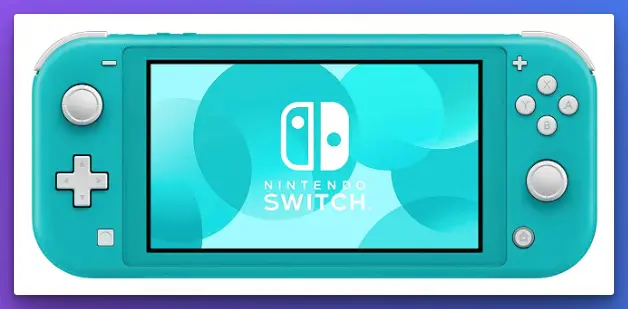
The Nintendo Switch Lite embodies a compact and lightweight form, perfectly suited for smaller hands, granting kids comfortable and prolonged gaming sessions. Its integrated controls provide effortless gameplay, ensuring an uninterrupted flow of excitement.
Despite its handheld exclusivity, the Nintendo Switch Lite boasts a vast game library, catering to various interests and age groups. From the whimsical charm of Animal Crossing: New Horizons to the thrilling escapades in Pokémon Sword and Shield, young players can indulge in captivating journeys.
Nintendo’s commitment to social gaming extends to the Nintendo Switch Lite, allowing kids to interact with friends through local wireless multiplayer, encouraging camaraderie and shared experiences.
As a console built with families in mind, the Nintendo Switch Lite offers robust parental control features, enabling guardians to manage screen time, control access to online features, and ensure a secure gaming environment.
In conclusion, the Nintendo Switch Lite as a game console for kids epitomizes portable perfection, delivering a remarkable gaming experience tailored to young players.
The console nurtures an environment where kids can immerse themselves in joyous and enriching virtual worlds with its vast game library, social gaming opportunities, and family-friendly design.
The Nintendo Switch Lite undoubtedly stands as a beacon of delight, inviting children to embark on captivating adventures in the palm of their hands.
Pros:-
Portability: The Nintendo Switch Lite’s compact and lightweight design makes it easy for kids to carry and play games on the go, providing entertainment during travel and outings.
Kid-Friendly Design: The smaller form factor and integrated controls of the Nintendo Switch Lite are well-suited for smaller hands, ensuring comfortable and effortless gameplay for young players.
Vast Game Library: Despite being a handheld console, the Nintendo Switch Lite offers access to a diverse and extensive game library catering to various interests and age groups.
Social Interaction: With local wireless multiplayer features, kids can enjoy playing with friends, fostering social interaction and shared gaming experiences.
Parental Control Features: The Nintendo Switch Lite provides robust parental control options, allowing parents to manage screen time, restrict access to certain content, and create a safe gaming environment.
Cons:-
Limited to Handheld Mode: Unlike the standard Nintendo Switch, the Switch Lite is exclusively a handheld console, meaning kids cannot connect it to a TV for a larger screen gaming experience.
No Detachable Joy-Cons: The lack of detachable Joy-Cons on the Nintendo Switch Lite may limit certain gameplay experiences that require motion controls or specific controller configurations.
Game Compatibility: Some games may not be optimized for handheld play, and certain titles may require additional accessories or a standard Nintendo Switch for full functionality.
Smaller Screen: The smaller screen size of the Nintendo Switch Lite may not offer the same immersive experience as playing on a larger TV or the standard Nintendo Switch.
Limited Multiplayer Options: While local wireless multiplayer is available, the absence of a built-in kickstand and detachable Joy-Cons may limit multiplayer options for certain games.
Despite these limitations, the Nintendo Switch Lite’s portability, kid-friendly design, vast game library, social interaction features, and parental control options make it an excellent game console for kids who prefer handheld gaming and on-the-go entertainment.
Age Group Recommendations:-
Young Children (Ages 6-9): The Nintendo Switch Lite offers a selection of games suitable for young children, featuring colorful visuals, simple gameplay mechanics, and educational content. Parental supervision and age-appropriate game choices are crucial for this age group.
Preteens (Ages 10-12): As kids age, they can explore a broader range of games on the Nintendo Switch Lite. At this stage, they may enjoy more challenging games that involve problem-solving, creativity, and social interaction.
Teenagers (Ages 13+) can fully embrace the Nintendo Switch Lite, delving into more complex and strategic games. The console’s multiplayer capabilities provide opportunities for online gaming and bonding with friends.
Parents must set appropriate screen time limits, encourage breaks, and ensure that the content their children access aligns with their maturity level. Additionally, utilizing the parental control features of the Nintendo Switch Lite can further enhance a safe and enjoyable gaming experience for kids of all ages.
Popular kid’s games available on the platform:-
The Nintendo Switch Lite offers many popular kids’ games that provide enjoyable and family-friendly experiences. Here are some of the most beloved and widely acclaimed kids’ games available on the platform:
Animal Crossing: New Horizons: Embark on a charming and relaxing life simulation game where kids can create their dream island paradise, befriend adorable animal villagers, and express their creativity.
Mario Kart 8 Deluxe: Race with beloved Nintendo characters in thrilling kart races, using power-ups and skill to secure victory on fun and colorful tracks.
Minecraft: Enter the blocky world of Minecraft, where kids can build, explore, and craft their adventures in a limitless virtual sandbox.
Pokémon Sword and Shield: Become a Pokémon Trainer and explore the Galar region, catching and training Pokémon to become the Champion.
Super Mario Odyssey: Join Mario on an epic 3D platforming adventure across various imaginative worlds to rescue Princess Peach from Bowser’s clutches.
Luigi’s Mansion 3: Embark on a spooky and comical journey as Luigi, equipped with the Poltergust G-00, to rescue his friends from the haunted Last Resort hotel.
Splatoon 2: Engage in colorful and chaotic team-based battles as squid-like Inklings in this unique, family-friendly multiplayer shooter.
Yoshi’s Crafted World: Help Yoshi navigate charming and crafty side-scrolling levels, uncovering secrets and collecting items in this delightful platformer.
Kirby Star Allies: Accompany Kirby on a heartwarming journey, befriending enemies and combining their powers to save Dream Land in this charming platformer.
Super Mario Party: Enjoy a collection of mini-games with friends and family as you compete and cooperate in various entertaining challenges.
These popular kids’ games on the Nintendo Switch Lite offer engaging gameplay, creative worlds, and family-friendly content, making the console an excellent choice for young players and their families.
5. Xbox Series S
The Xbox Series S has swiftly garnered attention as a versatile gaming console, and its allure extends to young players. As the best budget game console for kids, the Xbox Series S offers many exciting features, making it a top choice for children seeking thrilling virtual adventures and interactive entertainment.
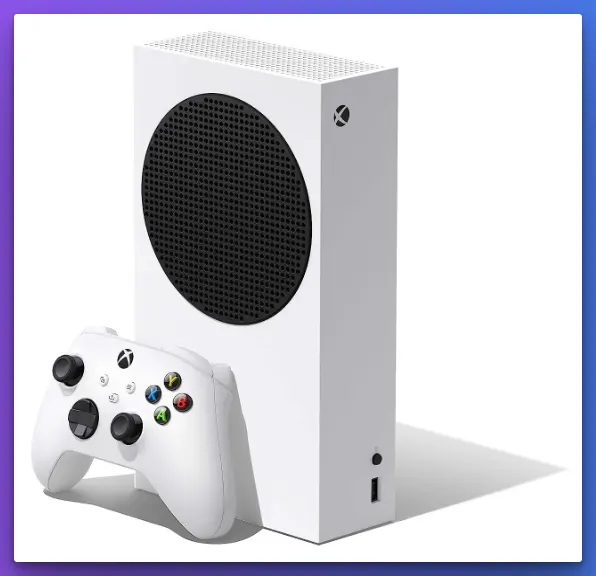
The Xbox Series S packs a punch with its custom AMD RDNA 2 architecture, delivering impressive graphics and smooth gameplay. Its compact form makes it easily accessible for kids, fitting seamlessly into their gaming world.
With access to an extensive gaming library, the Xbox Series S caters to various interests and age groups. From action-packed adventures to creative sandbox games, there’s something for every young player’s taste.
Microsoft emphasizes family-friendly gaming, ensuring that the Xbox Series S provides kids with a safe and enjoyable gaming environment. Robust parental controls allow caregivers to manage screen time, content access, and communication features.
The Xbox Series S opens up a world of online multiplayer gaming, allowing kids to connect and play with friends, promoting teamwork and social interaction.
Beyond entertainment, the Xbox Series S offers educational and creative experiences through games that promote problem-solving, critical thinking, and artistic expression, fostering a well-rounded gaming journey.
In conclusion, as the best game console for kids, the Xbox Series S exemplifies a harmonious balance of power, diverse content, child-friendly features, and educational potential. Whether embarking on heroic quests or venturing into imaginative realms, the Xbox Series S becomes a gateway to boundless excitement and growth for young players.
Pros:-
Affordable Entry Point: The Xbox Series S is a cost-effective option for families, providing access to next-gen gaming experiences at a lower price point.
Impressive Performance: Despite its smaller size, the Xbox Series S delivers impressive performance with its custom AMD RDNA 2 architecture, offering smooth graphics and fast load times.
Vast Game Library: The console provides access to various games, including family-friendly and child-appropriate titles, catering to various interests and age groups.
Compact and Portable: The Xbox Series S’s compact design makes it easy for kids to set up and move, allowing for gaming in various locations.
Enhanced Online Multiplayer: Young players can enjoy engaging online multiplayer experiences, connecting and playing with friends, fostering social interaction and teamwork.
Cons:-
Limited Storage: The Xbox Series S has a smaller storage capacity, which may fill up quickly with game downloads and updates, requiring additional storage solutions.
No Physical Disc Drive: The absence of a physical disc drive limits the console’s ability to play physical game discs, requiring digital downloads for game purchases.
Less Powerful Than Xbox Series X: While cost-effective, the Xbox Series S is less powerful than its counterpart, the Xbox Series X, which may impact the graphical performance of certain games.
1080p Gaming: The Xbox Series S is limited to 1080p resolution gaming, which may not provide the same visual fidelity as 4K gaming on the Xbox Series X.
Not Compatible With All Xbox One Accessories: Some Xbox One accessories, such as Kinect, are incompatible with the Xbox Series S, potentially limiting accessory options for kids.
Despite these limitations, the Xbox Series S’s affordability, impressive performance, vast game library, enhanced online multiplayer capabilities, and family-friendly features make it a solid choice as a game console for kids. It’s compact design and accessible gameplay ensure young players can immerse themselves in exciting gaming experiences without breaking the bank.
Age Group Recommendations:-
Younger Children (Ages 8-10): The Xbox Series S offers a selection of family-friendly games suitable for younger children. Parental supervision and age-appropriate game choices are essential for this age group.
Preteens (Ages 11-12): As kids age, they can explore a broader range of games on the Xbox Series S. At this stage, they may enjoy games that involve more complex gameplay mechanics and narratives.
Teenagers (Ages 13+): Teenagers can fully embrace the capabilities of the Xbox Series S, engaging in more challenging and strategic games. The console’s enhanced online multiplayer features also provide opportunities for social gaming with friends.
Parents must set appropriate screen time limits, encourage breaks, and ensure that the content their children access aligns with their maturity level. Additionally, the console’s parental control features can enhance a safe and enjoyable gaming experience for kids of all ages.
Popular kid’s games available on the platform:-
The Xbox Series S offers various popular kids’ games that provide engaging and family-friendly experiences. Here are some of the most beloved and widely acclaimed kids’ games available on the platform:
Minecraft: Enter the blocky world of Minecraft, where kids can build, explore, and craft their adventures in a limitless virtual sandbox.
Roblox: Join a vast online community where kids can create games, play games created by others, and engage in social interactions.
LEGO Video Games Series: Enjoy a collection of LEGO-themed video games based on popular franchises like LEGO Star Wars, LEGO Marvel Super Heroes, and LEGO Harry Potter.
Super Mario Odyssey: Join Mario on an epic 3D platforming adventure across various imaginative worlds to rescue Princess Peach from Bowser’s clutches.
Animal Crossing: New Horizons: Embark on a charming and relaxing life simulation game, where kids can create their dream island paradise, make friends with adorable animal villagers, and express their creativity.
Pokémon Sword and Shield: Become a Pokémon Trainer and explore the Galar region, catching and training Pokémon to become the Champion.
Super Lucky’s Tale: Embark on a delightful platforming adventure with Lucky, the curious and endearing fox, as he seeks to save the Book of Ages.
Sonic Mania: Speed through classic and revamped Sonic levels as the iconic blue hedgehog, Sonic, and his friends.
Yoshi’s Crafted World: Help Yoshi navigate charming and crafty side-scrolling levels, uncovering secrets and collecting items in this delightful platformer.
Crash Bandicoot 4: It’s About Time: Play as Crash or Coco in this action-packed platformer, traveling through time and space to thwart the evil Dr. Neo Cortex.
These popular kids’ games on the Xbox Series S offer entertaining gameplay, creative worlds, and family-friendly content, making the console an excellent choice for young players and their families.
6. PlayStation 4 Pro
The PlayStation 4 Pro, a powerhouse in the gaming world, stands tall as a compelling choice for young gamers seeking immersive adventures and interactive play.
As the best game console for kids, the PlayStation 4 Pro offers a captivating gaming experience rich with innovation and a diverse library of family-friendly titles.
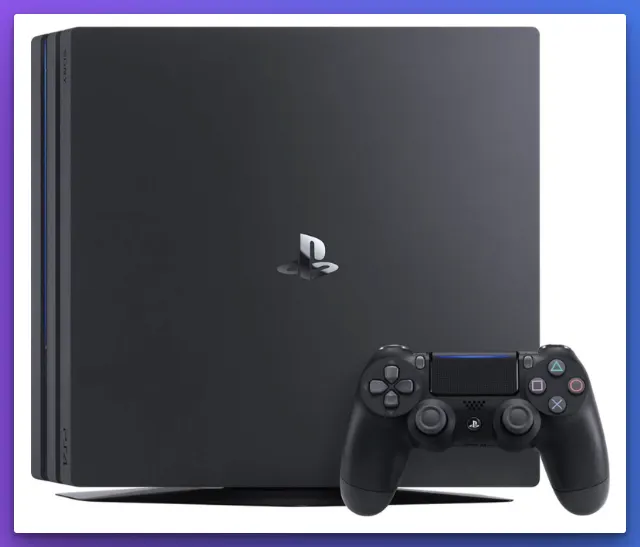
With its beefed-up hardware and enhanced graphics processing, the PlayStation 4 Pro delivers stunning visuals and seamless gameplay, captivating young players with its mesmerizing realism and fluidity.
Diving into the PlayStation 4 Pro’s extensive game library, kids will find a treasure trove of delightful games that cater to various interests and age groups. From whimsical platformers to epic adventures, the console’s repertoire has something for every young gamer.
The PlayStation 4 Pro entices kids into worlds of wonder and excitement with games that challenge their skills, spark their creativity, and foster imaginative storytelling.
Beyond entertainment, the PlayStation 4 Pro offers games that stimulate learning and problem-solving. From historical narratives to scientific explorations, young players can engage in educational experiences beyond the traditional classroom.
As a responsible gaming platform, the PlayStation 4 Pro allows parents to manage their child’s gaming experiences. With robust parental control features, caregivers can regulate screen time, control access to certain content, and ensure a safe gaming environment.
In conclusion, the PlayStation 4 Pro, as the best game console for kids, elevates the gaming journey for young players, providing top-tier performance, an extensive game library, interactive gameplay, educational value, and enhanced parental control features.
As kids embark on thrilling virtual escapades, the PlayStation 4 Pro is a gateway to endless excitement and growth.
Pros:-
Enhanced Gaming Performance: The PlayStation 4 Pro’s powerful hardware and enhanced graphics capabilities offer stunning visuals and smooth gameplay, providing an immersive gaming experience for kids.
Extensive Game Library: With a vast selection of family-friendly and kid-appropriate games, the PlayStation 4 Pro offers various titles to suit various interests and preferences.
Interactive and Immersive Gameplay: The console’s interactive mechanics and captivating storytelling games keep young players entertained for hours.
Educational Content: The PlayStation 4 Pro provides games that foster problem-solving, critical thinking, and learning, offering a valuable gaming experience.
Parental Control Features: With robust parental control options, parents can set limits on screen time, control content access, and ensure a safe gaming environment for their kids.
Cons:-
High Price Point: The PlayStation 4 Pro’s initial cost and additional expenses for games and accessories may be a significant investment for families.
Limited 4K Support: While the console supports 4K gaming and media playback, not all games are optimized for 4K resolution, potentially limiting the hardware’s full potential.
No Backward Compatibility with PS5: The PlayStation 4 Pro does not offer full backward compatibility with the PlayStation 5, which may affect future game compatibility.
Loud Fan Noise: The console’s cooling fan can be noisy during intense gaming sessions, which may concern some families, especially in quiet environments.
Online Subscription Required: Accessing online multiplayer and certain features requires a PlayStation Plus subscription, adding an ongoing cost to the gaming experience.
Despite these drawbacks, the PlayStation 4 Pro’s enhanced gaming performance, extensive game library, interactive gameplay, educational content, and parental control features make it a compelling choice as the best game console for kids, providing endless hours of fun and excitement in a safe and enriching gaming environment.
Age Group Recommendations:-
Preteens (Ages 10-12): The PlayStation 4 Pro offers a diverse selection of family-friendly games suitable for preteens. Children can handle more complex gameplay mechanics at this age and enjoy various titles.
Teenagers (Ages 13-17): Teenagers can fully embrace the capabilities of the PlayStation 4 Pro, engaging in more challenging games that offer deeper narratives, strategic gameplay, and online multiplayer experiences.
Parental Guidance: While the PlayStation 4 Pro provides a vast library of family-friendly games, it also offers titles with content more suitable for older players. Parents should actively monitor their children’s games and use the console’s parental control features to ensure a safe gaming experience.
Parents must set appropriate screen time limits, encourage breaks, and ensure that the content their children access aligns with their maturity level. Parents can create a positive gaming experience that caters to their child’s age and individual development by providing proper guidance and supervision.
Popular kids’ games available on the platform:-
The PlayStation 4 Pro offers many popular kids’ games that provide entertaining and family-friendly experiences. Here are some of the most beloved and widely acclaimed kids’ games available on the platform:
Minecraft: Enter the blocky world of Minecraft, where kids can build, explore, and create their adventures in a limitless virtual sandbox.
LEGO Video Games Series: Enjoy a collection of LEGO-themed video games based on popular franchises like LEGO Star Wars, LEGO Marvel Super Heroes, and LEGO Harry Potter.
Crash Bandicoot N. Sane Trilogy: Relive the classic adventures of Crash Bandicoot in stunning remastered versions, offering platforming fun for kids.
Spyro Reignited Trilogy: Join Spyro the Dragon on a magical journey as kids explore vibrant worlds, solve puzzles, and rescue dragon friends.
Ratchet & Clank: Embark on an intergalactic adventure with Ratchet and his robot companion Clank, filled with humor, action, and imaginative weapons.
LittleBigPlanet 3: Spark creativity and teamwork in this charming platformer, where kids can design and share their levels with others.
Rayman Legends: Join Rayman and his friends in a colorful, whimsical, platforming adventure filled with unique challenges and delightful visuals.
Sackboy: A Big Adventure: Follow Sackboy on an epic 3D platforming journey filled with puzzles, platforming challenges, and imaginative levels.
Disney Infinity Series: Merge physical toys with virtual worlds in the Disney Infinity games, allowing kids to explore interactive playsets based on Disney, Pixar, Marvel, and Star Wars characters.
Sonic Mania: Speed through classic and revamped Sonic levels as the iconic blue hedgehog, Sonic, and his friends.
These popular kids’ games on the PlayStation 4 Pro provide engaging gameplay, vibrant worlds, and family-friendly content, making the console an excellent choice for young players and their families.
7. Nintendo 2DS XL
The Nintendo 2DS XL, donned in an enticing Black + Turquoise design, takes center stage as a remarkable game console for young players, igniting a world of thrilling adventures and interactive play. As the best game console for kids, the Nintendo 2DS XL brings a delightful array of features and an extensive library of captivating games.
The Nintendo 2DS XL boasts a sleek and portable design, perfectly fitting small hands, enabling kids to immerse themselves in gaming escapades on the go. Its clamshell form factor ensures both protection and playability.
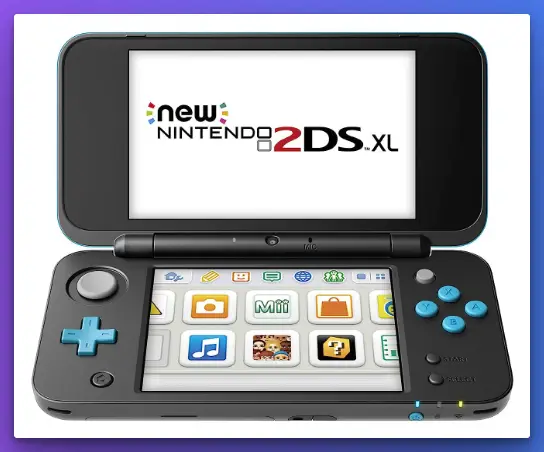
With its dual large screens and powerful processing capabilities, the Nintendo 2DS XL offers an immersive gameplay experience, transporting young players into enchanting worlds filled with wonder and excitement.
The Nintendo 2DS XL opens a gateway to a vast game library, brimming with family-friendly titles. From classic Nintendo franchises to innovative new adventures, there’s something to captivate every young gamer.
Nintendo prioritizes safety with the Nintendo 2DS XL, incorporating robust parental control features, allowing guardians to manage screen time, restrict access to online features, and ensure a secure gaming environment.
The Nintendo 2DS XL features built-in Amiibo support, enriching gameplay experiences by unlocking additional content and enhancing interactions with compatible games.
In conclusion, the Nintendo 2DS XL as the best game console for kids weaves portability, immersive gameplay, a diverse game library, safety features, and Amiibo integration, crafting a gaming wonderland for young players.
Through thrilling adventures and captivating challenges, the Nintendo 2DS XL stands as a trusted companion, igniting the spark of joy and creativity in the hearts of young gamers.
Pros:-
Portable Design: The Nintendo 2DS XL’s compact and lightweight design makes it easy for kids to carry and play games on the go, providing entertainment during travel and outings.
Large Dual Screens: The console’s dual large screens enhance the gaming experience, providing clear visuals and an immersive environment for young players.
Extensive Game Library: With access to a diverse and family-friendly game library, the Nintendo 2DS XL offers various titles to cater to various interests and age groups.
Affordability: The Nintendo 2DS XL is a cost-effective option compared to other gaming consoles, making it accessible to families on a budget.
Parental Control Features: The console provides robust parental control options, allowing parents to set screen time limits, restrict access to online features, and create a safe gaming environment.
Cons:-
No 3D Capability: Unlike its predecessor, the Nintendo 3DS, the 2DS XL lacks 3D capability, which may limit certain gameplay experiences for kids.
Limited Game Compatibility: Some games are designed specifically for the 3DS and may not be fully optimized or compatible with the 2DS XL.
Small Game Library: While the game library is diverse, it may not have as many new releases or exclusive titles as other gaming platforms.
No TV Connectivity: The Nintendo 2DS XL is a handheld console that cannot be connected to a TV for larger-screen gaming.
Battery Life: The battery life of the Nintendo 2DS XL may be shorter during intensive gaming sessions, requiring periodic recharging.
Despite these limitations, the Nintendo 2DS XL’s portability, large screens, extensive game library, affordability, and parental control features make it a compelling choice as the best game console for kids.
It’s user-friendly design and wide range of family-friendly games ensure that young players can enjoy hours of entertainment in a safe and enjoyable gaming environment.
Age Group Recommendations:-
Young Children (Ages 6-8): The Nintendo 2DS XL offers a selection of age-appropriate and family-friendly games suitable for young children. Parental supervision and age-appropriate game choices are essential for this age group.
Preteens (Ages 9-12): As kids age, they can explore a broader range of games on the Nintendo 2DS XL. At this stage, they may enjoy more challenging games that involve problem-solving, creativity, and strategic thinking.
Teenagers (Ages 13+): Teenagers can fully embrace the capabilities of the Nintendo 2DS XL, engaging in more complex and immersive gaming experiences.
Parents must set appropriate screen time limits, encourage breaks, and ensure that the content their children access aligns with their maturity level. Additionally, utilizing the parental control features of the Nintendo 2DS XL can further enhance a safe and enjoyable gaming experience for kids of all ages.
Popular kid’s games available on the platform:-
The Nintendo 2DS XL offers a delightful collection of popular kids’ games that provide enjoyable and family-friendly experiences. Here are some of the most beloved and widely acclaimed kids’ games available on the platform:
Animal Crossing: New Leaf: Embark on a charming life simulation game where kids can create and manage their virtual village, interact with adorable animal villagers, and customize their living space.
Mario Kart 7: Race with beloved Nintendo characters in fun and exhilarating kart races, using power-ups and skill to secure victory on colorful and imaginative tracks.
Pokémon Ultra Sun and Ultra Moon: Become a Pokémon Trainer and explore the Alola region, catching and training Pokémon to become the Pokémon Champion.
Super Mario 3D Land: Join Mario on a thrilling 3D platforming adventure, navigating through cleverly designed levels to rescue Princess Peach from Bowser’s clutches.
Luigi’s Mansion: Dark Moon: Embark on a comical and spooky journey as Luigi, armed with the Poltergust 5000, to capture ghosts and uncover secrets in multiple haunted mansions.
Kirby: Planet Robobot: Help Kirby save Dream Land from mechanized invaders in this charming, action-packed platformer.
Yo-Kai Watch Series: Dive into the world of Yo-Kai and befriend playful spirits while solving mysteries and helping people in this imaginative role-playing game.
New Super Mario Bros. 2: Enjoy classic 2D side-scrolling action as Mario, collecting coins and power-ups while rescuing Princess Peach from Bowser.
Donkey Kong Country Returns 3D: Join Donkey Kong and Diddy Kong in a thrilling jungle adventure, battling enemies and navigating challenging platforming levels.
Mario & Luigi: Dream Team: Embark on a humorous and whimsical RPG journey with Mario and Luigi as they explore Luigi’s dreams and save the world from evil forces.
These popular kids’ games on the Nintendo 2DS XL offer engaging gameplay, colorful visuals, and family-friendly content, making the console an excellent choice for young players and their families.
Portable vs Stationary Consoles: A Comprehensive Comparison
Players are presented with a critical choice in gaming: Portable or Stationary Consoles? Each option has distinct features and attributes catering to different gaming preferences and lifestyles.
Understanding the nuances between these two gaming platforms can empower players to make an informed decision that aligns perfectly with their gaming aspirations.
Portability and Mobility:-
Portable Consoles such as the Nintendo Switch and PlayStation Vita redefine gaming convenience. Designed for on-the-go gaming, these devices boast compactness, lightweight construction, and battery-powered capabilities, enabling players to indulge in immersive gaming experiences anywhere, anytime.
Whether commuting on a train, embarking on a family trip, or simply lounging in the park, portable consoles deliver a seamless fusion of gaming and mobility.
On the other hand, Stationary Consoles like the PlayStation 5 and Xbox Series X dominate the realm of home gaming. Their robust hardware and expansive storage capacity offer unparalleled graphical fidelity and processing power. Stationary consoles remain tethered to a designated gaming space, delivering epic, large-scale experiences on high-definition TVs.
Game Library and Performance:-
Despite their size, portable consoles sport a robust game library, featuring many exclusive titles and family-friendly games. The Nintendo Switch, renowned for its first-party franchises like Mario and Zelda, exemplifies this prowess, captivating players of all ages.
However, regarding raw performance and graphics, portable consoles may fall short compared to their stationary counterparts.
Stationary consoles boast the most extensive and graphically impressive game catalog, offering immersive open-world epics, graphically-intensive AAA titles, and cutting-edge gaming experiences. Gamers seeking the pinnacle of gaming performance and visual fidelity find sanctuary in stationary consoles.
Social Interaction and Multiplayer:-
Portable consoles facilitate local multiplayer experiences thanks to their built-in controllers and adaptability to spontaneous gatherings. Players can effortlessly share joyous moments and engage in multiplayer escapades on a single device, making them ideal for social gamers.
In contrast, stationary consoles embrace online multiplayer capabilities, connecting players across the globe for intense battles and cooperative endeavors. Console-specific online platforms like Xbox Live and PlayStation Network enrich the social gaming experience, fostering virtual communities and friendships.
Cost and Investment:-
Portable consoles generally offer a more budget-friendly entry point compared to stationary consoles. They provide an affordable gateway into gaming and are especially appealing to younger audiences and casual gamers seeking accessible entertainment.
Stationary consoles command a higher initial investment, yet they deliver unparalleled gaming potential and serve as future-proof entertainment hubs, offering cutting-edge technology and enduring value.
In the eternal debate of Portable vs Stationary Consoles, the choice ultimately rests on individual preferences, lifestyle, and gaming aspirations. Portable consoles enchant with their convenience and mobility, while stationary consoles captivate with their performance and expansive game libraries.
Whichever path players traverse, the gaming world unveils many breathtaking experiences, forging unforgettable memories for players, young and old.
The Impact of Virtual Reality (VR) Consoles for Kids
In recent years, Virtual Reality (VR) Consoles have ushered in a new era of immersive gaming experiences, profoundly impacting children’s gaming world.
VR technology has the power to transcend conventional gaming, offering a realm of interactive possibilities that stimulate the senses and fuel young minds with wonder and excitement.
1. Unparalleled Immersion
One of the most remarkable aspects of VR consoles is their ability to transport young players into virtual worlds with an unparalleled sense of immersion. With VR headsets donned, kids can step into the shoes of their in-game avatars, exploring fantastical realms and interacting with virtual environments like never before.
This heightened sense of presence creates a deeper emotional connection with the gaming experience, simultaneously engaging their minds and emotions.
2. Enhanced Learning and Creativity
Beyond entertainment, VR consoles offer a potent platform for learning and creativity. Educational VR games and experiences engage children in interactive lessons, historical reconstructions, and scientific explorations, fostering a love for learning in a dynamic and captivating manner.
Moreover, VR creation tools empower kids to unleash their creativity, allowing them to build and design within virtual spaces, sparking innovation and artistic expression.
3. Physical Activity and Health Benefits
Contrary to sedentary gaming experiences, VR consoles encourage physical movement and active play. Games that incorporate physical gestures and body movements promote exercise and active participation, contributing to a healthier gaming lifestyle.
4. Social Interaction and Empathy
VR multiplayer experiences bridge the physical gap, enabling kids to connect and interact with friends and fellow gamers in virtual environments. Collaborative VR adventures build teamwork skills and enhance social bonds, promoting empathy and communication among young players.
5. Cognitive and Spatial Skills Development
The 3D nature of VR environments challenges kids’ cognitive and spatial skills. Navigating virtual spaces, solving puzzles, and making strategic decisions in VR games sharpen problem-solving abilities and enhance spatial awareness.
6. Parental Involvement and Safety
As with gaming technology, parental involvement remains crucial when introducing VR consoles to kids. Ensuring age-appropriate content, setting time limits, and providing supervision fosters a safe and positive gaming experience.
In conclusion, the impact of Virtual Reality (VR) consoles for kids transcends entertainment, extending into the realms of learning, creativity, physical activity, and social interaction.
Embracing this revolutionary technology with responsible guidance can enrich children’s lives, opening doors to a world of imagination and possibilities through the boundless realms of virtual reality.
How to Encourage Healthy Gaming Habits in Kids
In today’s digital age, gaming has become integral to many children’s lives. As parents and caregivers, it is essential to foster healthy gaming habits in kids to ensure a balanced and positive gaming experience.
By incorporating mindful strategies and setting appropriate boundaries, we can empower our young players to harness the benefits of gaming while maintaining a healthy lifestyle.
1. Set Time Limits and Schedule Gaming Sessions
Establishing time limits for gaming sessions is crucial to prevent excessive screen time and maintain a healthy balance between virtual and real-world activities. Create a daily or weekly gaming schedule allowing ample time for other essential activities such as homework, outdoor play, and family interactions.
2. Choose Age-Appropriate Games
Selecting age-appropriate games is paramount in shaping a child’s gaming experience. Look for games with educational value, positive themes, and suitable content that aligns with their developmental stage. Playing games promoting problem-solving, creativity, and critical thinking can benefit their overall growth.
3. Create a Game-Friendly Environment
Designate a game-friendly environment for kids to indulge in gaming comfortably. Ensure proper lighting, seating, and screen positioning to reduce eye strain and promote ergonomic gameplay. Keep gaming consoles or devices in communal spaces, allowing for parental oversight and interaction.
4. Encourage Physical Activity
Balance gaming with physical activity to promote a healthy lifestyle. Encourage kids to take regular breaks from gaming to engage in outdoor play, sports, or other physical exercises. Some games even incorporate motion-based gameplay, offering a fun way to combine gaming and physical movement.
5. Emphasize Social Interaction
Gaming can be a social activity. Encourage kids to interact with friends and family through multiplayer gaming or cooperative play. Building positive social connections within gaming can enhance teamwork skills and empathy.
6. Model Healthy Gaming Behavior
As role models, adults should model healthy gaming behavior themselves. Demonstrating responsible gaming habits and adhering to time limits sends a powerful message to children about the importance of balance and moderation.
7. Use Parental Controls
Leverage parental control features on gaming devices to regulate content access, screen time, and in-game purchases. Parental controls offer additional safety and guidance in children’s gaming experiences.
In conclusion, fostering healthy gaming habits in kids involves a thoughtful approach that incorporates time management, age-appropriate game choices, physical activity, and parental involvement. By cultivating a positive gaming environment and setting clear boundaries, we can ensure that gaming becomes an enjoyable and beneficial part of their childhood journey.
📗FAQ’s
What is the most kid-friendly game console?
The Nintendo Switch is widely regarded as the most kid-friendly game console due to its intuitive controls, family-friendly game library, and portability.
| No. | Game Console | Age Group | User Ratings (Out of 5) | Popular Games |
|---|---|---|---|---|
| 1. | Nintendo Switch | 6+ | 4.7 | Super Mario Odyssey, The Legend of Zelda, Animal Crossing |
| 2. | PlayStation 5 | 10+ | 4.5 | Ratchet & Clank: Rift Apart, Spider-Man: Miles Morales |
| 3. | Xbox Series X | 10+ | 4.3 | Halo Infinite, Forza Horizon 4 |
| 4. | Nintendo Switch Lite | 6+ | 4.5 | Luigi’s Mansion 3, Pokémon Sword and Shield |
| 5. | Xbox Series S | 10+ | 4.2 | Minecraft, Ori and the Will of the Wisps |
| 6. | PlayStation 4 Pro | 10+ | 4.3 | LittleBigPlanet 3, Crash Bandicoot N. Sane Trilogy |
| 7. | Nintendo 2DS XL | 7+ | 4.1 | New Super Mario Bros. 2, Kirby’s Extra Epic Yarn |
| 8. | Nintendo 3DS | 7+ | 4.2 | Mario Kart 7, Pokémon Ultra Sun & Ultra Moon |
| 9. | Xbox One S | 10+ | 4.2 | Roblox, Lego Marvel Super Heroes |
| 10. | PlayStation VR | 12+ | 4.0 | Beat Saber, Moss, Astro Bot: Rescue Mission |
| 11. | Oculus Quest 2 | 13+ | 4.5 | Beat Saber, SuperHot VR, Job Simulator |
| 12. | Sega Genesis Mini | 8+ | 4.0 | Sonic the Hedgehog, Earthworm Jim, Streets of Rage 2 |
| 13. | Atari Flashback 9 | 10+ | 3.8 | Space Invaders, Frogger, Pong |
| 14. | LeapFrog LeapTV | 3-8 | 4.2 | LeapFrog Sports, Bubble Guppies, Dora the Explorer |
| 15. | VTech InnoTV | 3-8 | 4.1 | Mickey Mouse Clubhouse, Paw Patrol, Go! Go! Smart Wheels |
What game console is best for a 5-year-old?
The Nintendo Switch Lite is an excellent choice for a 5-year-old, offering a durable handheld design and a variety of age-appropriate games.
Which game system is better for kids?
Both the Nintendo Switch and PlayStation offer kid-friendly content, but the Nintendo Switch’s versatility and ease of use make it a popular choice for young gamers.
Which game console is best for a 4-year-old?
The LeapFrog LeapPad is a fantastic option for a 4-year-old, providing educational games and interactive learning experiences.
What age should kids buy gaming consoles?
The appropriate age for kids to start gaming varies, but ages 6 and above are generally suitable, depending on their maturity and interests.
What age should a kid get a console?
Around ages 7 to 8 is a common age range for kids to receive their first gaming console, but parental discretion is advised.
Is it OK for 5-year-olds to play video games?
Yes, playing age-appropriate and supervised video games can benefit 5-year-olds, such as improving hand-eye coordination and problem-solving skills.
Can you play Roblox on Nintendo Switch?
Roblox is available on the Nintendo Switch, allowing players to enjoy the popular online platform and its user-created games.
What age is the Nintendo Switch for?
The Nintendo Switch is suitable for children aged 6 and above, but some games may be appropriate for younger kids with parental guidance.
Is PlayStation or Nintendo better for kids?
Both PlayStation and Nintendo offer kid-friendly content, but Nintendo’s focus on family-friendly games and easy-to-use consoles may make it more appealing to parents of young children.
Is the Nintendo Switch OK for 5-year-olds?
Yes, the Nintendo Switch is suitable for 5-year-olds, especially with its wide range of age-appropriate games and handheld mode for ease of use.
Why is the Nintendo Switch good for kids?
The Nintendo Switch offers a family-friendly gaming experience, promotes creativity and learning through games, and encourages social interaction through multiplayer options.
What is the best console for beginners?
The Nintendo Switch or the Xbox Series S are great for beginners, providing user-friendly interfaces and diverse game libraries.
Is the Nintendo Switch suitable for a 4-year-old?
While some games are appropriate for 4-year-olds, the Nintendo Switch Lite may be a better fit due to its durability and simpler design.
What is similar to Wii?
The Nintendo Switch shares similarities with the Wii, such as motion controls and family-friendly games, making it a natural successor to the beloved console.
What’s better, Xbox, or PlayStation?
Xbox and PlayStation have their strengths, but Xbox’s family-friendly options, such as Xbox Game Pass, may appeal more to parents of young children.
Should I get my 5-year-old an Xbox?
The Xbox Series S is suitable for a 5-year-old, but parental supervision and age-appropriate game choices are essential.
Should I let my 7-year-old play video games?
Allowing a 7-year-old to play video games in moderation and with age-appropriate content can provide entertainment and skill development.
Should a 6-year-old have a PlayStation?
A PlayStation console, like the PlayStation 5, can be suitable for a 6-year-old with parental oversight and access to kid-friendly games.
What is the minimum age for PlayStation?
The PlayStation is not recommended for children under 6 due to the complexity of gameplay and the need for parental supervision.
What is the minimum age for Xbox?
Xbox consoles are generally not recommended for children under 6, but Xbox offers parental control features for safe gaming experiences.
Should I let my 4-year-old play video games?
Introducing supervised and age-appropriate video games for short periods can be acceptable for 4-year-olds, but moderation is key.
Do video games affect children’s behavior?
Extensive research suggests that video games can influence children’s behavior, but parental involvement and age-appropriate content play significant roles.
What is the youngest age to play video games?
Children as young as 2 or 3 can be introduced to simple and educational games with parental guidance.
Is Roblox safe for my kid?
Roblox has safety measures, but parental involvement and awareness of online interactions are essential to ensure a safe experience.
What consoles can Roblox be played on?
Roblox is available on various platforms, including the Nintendo Switch, PlayStation, and Xbox consoles.
Can you play Roblox on Switch or PlayStation?
Yes, Roblox can be played on the Nintendo Switch and PlayStation consoles, providing access to the popular online platform.
What is better, Xbox, or Nintendo Switch?
Choosing between Xbox and Nintendo Switch depends on individual preferences and the type of games and experiences desired.
Is a Nintendo Switch age-appropriate for a 6-year-old?
The Nintendo Switch is age-appropriate for 6-year-olds, offering a wide range of games suitable for young players.
Conclusion
The gaming world has much to offer kids, from honing their problem-solving skills to enhancing their creativity. With the right console, you can make gaming a beneficial and enjoyable part of their lives.
Finding the perfect console can be just as exciting as the games themselves. So take your time, evaluate your options, and make a choice that will bring your children countless hours of joy and entertainment.
Remember, the “best” console isn’t necessarily the one with the most features or the latest technology; it’s the one that best suits the needs and interests of your kids. Happy gaming!














